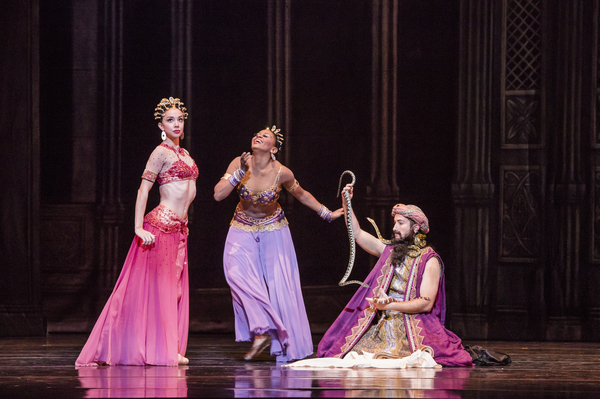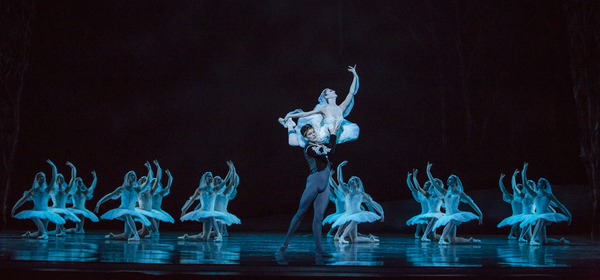
by Catherine L. Tully
Even when choosing a large-scale ballet Joffrey is unique–and “La Bayadere” is certainly a bold choice. The ballet was first performed in 1877 at the Bolshoi Theatre in St. Petersburg, and it was choreographed by Marius Petipa. This version has been updated by Houston Ballet’s marvelous Stanton Welch, and it is easy to see why he is one of the most sought after choreographers of our generation. He has the ability to create such interesting movement that one wishes they had two sets of eyes to see it all–especially when the stage is filled with dancers.
Although the three-act plot seems convoluted, at the center of it all it’s really just a tragic love triangle between Nikiya (the temple dancer, Victoria Jaiani), Solor (the warrior prince, Dylan Gutierrez) and Gamzatti (the Rajah’s daughter, April Daly). The first act is set in India and it traces the forbidden love story of Nikiya and Solor–and the plot to bring about her death, crafted by Gamzatti and her servant Ajah.
Jaiani is achingly supple–offering her submission to Solor with tender, fluttering arms and yielding bends of the torso. Gutierrez, although an able partner, was at his best when soaring and bounding across the stage with passionate abandon.
Welch’s choreography is both brilliant and difficult with demanding lifts, whiplash turns and unexpected combinations. In the first act, the dance for the four men was especially impressive, but the group dancing was also a joy to watch. Instead of tutus, tights and tiaras there are dazzling bras and colorful, flowing fabrics everywhere. The bright, jeweled costumes and lush scenery by Peter Farmer add quite a bit to the visual appeal of this ballet and Scott Speck and the Chicago Philharmonic added depth and drama with their mastery of the musical score by Minkus.
Fabrice Calmels is the perfect choice for the High Brahmin–radiating authority and confidence and dominating the stage with his presence. Also compelling were the musical John Mark Giragosian as Agni the Fire God and Erica Lynette Edwards as the maniacal Ajah.
The second act is set at the palace gardens as the wedding preparations for Solor and the princess Gamzatti take place. Daly was spectacular as she whipped off a triumphant series of fouettés and Jaiani was limp and heartbroken as she danced before the couple prior to her death.

The beginning of the third act is in stark contrast to the color and vibrant atmosphere of the other two–especially in the “Kingdom of the Shades” where women in all white tutus–ghostly images–dance in unison. One by one these figures come down a long ramp in arabesque, balancing, bending back, balancing again. A trance-like scene, this is where Joffrey was at its most impressive. With only a slight sway or quiver here and there, the company triumphed over one of the more difficult corps de ballet scenes in classical ballet. They moved as one.
The three “shade solos” were all danced with verve. Cara Marie Gary bounced fluently, Amber Neumann floated lightly and Amanda Assucena’s solid balance and incredible extension appeared effortless.
Once Solor returns to reality the end of this ballet becomes a whirlwind–exciting and dramatic, if somewhat frenzied after the otherworldly scene before it.
La Bayadere runs through October 27th at the Auditorium Theatre in Chicago.





“Jaiani is achingly supple–offering her submission to Solor with tender, fluttering arms and yielding bends of the torso.” I could NOT believe how limber and beautiful her back was! (Weird thing to hone in on? Probably.) But it had my jaw on the floor.
I also loved how over-the-top dramatic the whole thing was too! It had me giggling on more than one occasion. It was a fun night.
How fortunate are we to see all this magnificent dance this month? I’m blown away.
I know – I’m overwhelmed with the amount of fantastic dance in our fine city! So glad you enjoyed it too-perhaps one of these days we’ll run into one another! 😉
I’ve been surprised to read uniformly positive reviews of this ballet. I saw the show on Sunday afternoon and was very disappointed. I have seen this ballet on video many times (both the Mariinsky/Bolshoi and Makarova versions), and it is probably my favorite classical ballet because it is such a gorgeous example of pure academic ballet. I I was cautiously optimistic about the Joffrey’s production – I knew Welch had substantially revised the ballet, but I was really just excited to see the ballet performed for the first time in Chicago. From the beginning of Act 1, it was obvious that the Joffrey’s production was La Bayadere in name only. It was upsetting to see such a dramatically watered-down version of the ballet I love. Welch made so many unnecessary revisions to the ballet, the must egregious of which was the re-choreographing of Nikiya’s beautiful death scene at the end of Act 2. That variation is one of the most iconic, beautiful variations in all of classical ballet. It presents a tremendous opportunity for the ballerina to express a range of emotions, and the music is thrilling as well. I was excited to see Victoria Jianai interpret it since she has such a beautiful facility for ballet. I was floored when I saw Welch’s choreography, which was a short, shoddy substitute. I could go on – there are so many more examples of needless revisions, either to shorten the run time or for no reason at all. The Joffrey’s version has only 20 shades in Act 3 (reduced to 18 later on), not the iconic 32. Welch eliminated the Golden Idol, which is a fan favorite. The Joffrey has so many men that could have brought that variation to life, such as Aaron Rogers. The plot changes killed me too. Perhaps to make Nikiya appear more compelling, Welch took out her attempt to kill Gamzatti at the end of Act 2. The bizarre 4th Act with a myriad of stabbings made no sense; it would have been better to stick with the traditional 4th Act where Nikya’s ghost destroys the temple.
I guess I write this because I am surprised that I have not heard similar sentiments from any dance critic who reviewed this ballet.
Thanks for sharing your observations Stephanie – I always appreciate a thoughtful comment. I’ve seen both versions of the ballet you mentioned as well, but I don’t feel Welch’s version is watered down…just different. Although I can concur that Nikiya’s death seemed a bit abrupt, I think that the drama in the story remained strong (and well acted) overall. I have to say that I agree with the other reviewers in that it was a success, and was impressed that Joffrey did such a lovely job with it.
With Ballet West’s recent visit I wish I would have gotten to see their updated Sleeping Beauty, as I think it may well be the trend to update and shorten some of the classics. I would have liked to have seen how well that was done…
I guess it will always come down to the question of whether we should be sticking to the traditional staging/choreography of these time-honored ballets–or if we should alter them to appeal more to our current/future audience base. I’m not sure there is a right answer there–and I don’t really know what my thoughts on that are overall. I think both have value–so long as they are done well.
Thanks again for your comment!
Thanks for your response. I hope I was clear that my comments were directed towards Welch’s production and not towards the Joffrey’s execution of it. I agree there is tension between preserving the classics and appealing to modern audiences who don’t want to sit through a 3 hour ballet and don’t understand pantomime. It is a delicate balance. I just question removing some of the best parts of the ballet to achieve that balance.
I do think you were clear about that. It will be interesting to see what is to come in terms of how these ballets are adapted…on your other point, I believe we must agree to disagree. 🙂
Thanks for reading!